レポート
Key takeaways
Overview of the current conditions
The global economy moved ahead on its path towards recovery in 2013 with slow but steady growth. The growth in global GDP seems to be stabilising at approximately 2% per annum. The US weathered periods of uncertainty caused by the ‘fiscal cliff’ crisis, the debt-ceiling crisis and a 16-day government shutdown. The US Federal Reserve finally began to taper its bond-buying programme in December, signalling a slow return to normal. In spite of everything, the US GDP managed to grow at about 2% annually. In contrast, the euro zone economy continued to face stiff headwinds but managed to avoid a major contraction during 2013.
Growth in top emerging economies has slowed over the past year as new growth concerns and a modest flight of capital have pressured investments. The economies under the BRICS (Brazil, Russia, India, China and South Africa) and MINT (Mexico, Indonesia, Nigeria and Turkey) umbrellas grew at a combined rate of 5% from 2012 to 2013, relatively slower than the 6% annual growth seen from 2009 to 2013. India experienced its own set of economic troubles, starting with a gaping fiscal deficit, persistently high inflation, currency depreciation and pessimism among businesses and consumers. Consequently, the Indian economy only managed a GDP growth of 4.7% during 2013. Despite an overall slowdown, financial services, insurance, real estate and business services, as well as community, social and personal services, continued to grow at rates in excess of 6%. The Indian stock market remained flat through much of the year but saw an uptick in the last quarter, while the declining rupee has stabilised, suggesting that the cyclical flight from India may be abating. The Reserve Bank of India lowered repo rates in the first half of the year to boost slowing growth, while increasing inflation was countered by increasing repo rates in the second half. Despite the macroeconomic challenges, private equity continued to play a pivotal role in India’s capital needs, accounting for 54% of foreign direct investment inflows against 45% in 2012.
The impact of global macroeconomic changes is reflected in the increased deal activity. Global buyout value has gone up 22% in 2013, led by North America and Europe, which experienced growths of 24% and 36%, respectively. On the other hand, much of the Asia-Pacific region experienced a decline in PE activity, except India and Korea, which showed strong growth in deal values. In India, overall deal volume grew by 26%, with an increase in deal value of 16% ending the year at $11.8 billion but not quite a return to 2011 levels of $14.8 billion. Volume grew due to a sharp increase in early- and growth-stage deals sized less than $20 million, while deal value grew due to a few large-sized deals.
Looking at the year ahead, GPs in India continue to be concerned about macroeconomic conditions, exit environment challenges and valuation expectations in good-quality deals. The upcoming general elections are expected to play an important role in redefining the macroeconomic outlook and investment environment in India.
Most GPs and LPs we spoke with believe that PE asset allocation to India has declined in recent times, driven by the following key factors: lower-than-expected returns from investments, low liquidity and uncertainly around government policy and regulations. On the other hand, investors continue to believe in the long-term potential of India. They see the value of staying invested, but with increased caution and clarity.
Fund-raising
Funds allocated towards Asia-Pacific on a regional level continued to expand. On the other hand, country-focussed funds declined for India, China, Korea, Australia and New Zealand. Specifically, India-focussed fund allocation—excluding real estate and infrastructure—dropped by 40%, which contributed to dry powder shrinking in India to $8 billion (vs. $9 billion in 2012). However, there continues to be enough capital chasing good deals, especially because a significant amount of capital is also drawn into India via allocations from Asia-Pacific and global funds. In addition to this, several sovereign wealth funds have made large direct investments already—an example is the $237 million PIPE into Kotak Mahindra Bank by GIC—and will continue to draw funds from their deep pockets as interesting opportunities arise.
Fund-raising for India has become more difficult as LPs have intensified their scrutiny of who they trust with their fund commitments. They are now looking much more closely at factors like team stability, GP track record and investment philosophy.
Moreover, LPs are becoming more hands-on in order to pressure-test the quality of investments, assess value upside potential and ensure liquidity at the time of exit.
In the future, fund-raising will continue to be difficult as uncertainties about India’s macroeconomic situation remain, and the next wave of emerging economies in sub-Saharan Africa, Southeast Asia and Latin America present attractive avenues of investment. In such a scenario, GPs need to work harder on their existing portfolios to demonstrate their value-creation ability and differentiate themselves on operational capability and realisation with LPs.
Deal making
The overall volume of deals in India increased across sectors, growing by 26% overall, predominantly fuelled by the IT and ITES (information technology enabled services), healthcare and BFSI (banking, financial services and insurance) sectors. The top 25 deals comprised a higher share of total investments in 2013, standing at 55%, compared with 44% in 2012; the largest deal was the $1.26 billion PIPE into Bharti Airtel by Qatar Foundation Endowment. Investments in early- and growth-stage deals continued to surge in 2013 and comprised more than 70% of total deals made, up from 66% in 2012. The average size of PE deals, excluding real estate and venture capital (VC) deals, increased significantly, driven by a shift to larger deal sizes. A majority of GPs surveyed expect that average deal sizes will increase further in the next two to three years.
The Indian PE market continues to be dominated by minority investments, but the mix is slowly and steadily moving towards buyouts. The market seems to be rationalising, and valuations have shown signs of tempering. However, the overall level of competition in deals has not reduced, primarily due to a paucity of good-quality deals. GPs are taking more time to get comfortable with the fundamental value-creation potential of possible investments and doing more comprehensive diligence including all aspects of the business. GPs agree that relationships are becoming more important, and several funds are now seeing proprietary deals.
Though there is immense interest associated with the results of the general elections in April, GPs are cautiously optimistic about the prospects of the Indian PE and VC industry, with more than 35% of them expecting to see a growth of 10% to 25% in 2014 in terms of the investments made. Healthcare, technology and IT, and consumer products and retail are expected to be the most attractive sectors for PE and VC investments in the next two years.
While healthcare, technology and IT will be driven by export-oriented stories, domestic consumption will continue to power consumer products and retail.
In an environment where access to debt is low, owing to high interest rates and tight liquidity, the number of companies looking to raise private equity money should have been higher. However, in some cases promoters have pushed back their plans to raise capital until the macroeconomic environment and valuations improve.
Entrepreneurs’ understanding of PE proposition has improved considerably in the last few years. Indian entrepreneurs and management teams are appreciating the role of PE as being activist long-term capital that can positively contribute to value creation.
Portfolio management and exits
The past year saw a 43% increase in the number of exits in India, though the value of exited deals stayed flat at $6.8 billion. A comparison of investments and exits over the last few years shows that investments in sectors such as BFSI and IT and ITES have seen good liquidity and capital returns.
In 2013, lacklustre capital markets limited public market sales. Strategic and secondary sales gained importance, and several PE funds are preparing their portfolios for such exits. Funds coming to re-up points are also exploring promoter buybacks actively, even though these might not yield attractive returns.
The pressure to exit is expected to increase. If viable exits do not happen in the next couple of years, one could expect to see a shakeout in the industry as fund tenures come to expiry. Investors are looking at the general elections intently in anticipation of a resurgence in the Indian growth story. They specifically hope to see a clear mandate leading to stable and favourable regulations. In the meantime, PE funds will continue to get more hands-on with portfolio companies to ensure that exit stories are tight and lucrative.
LPs’ perspective of India
LPs have come to be dissatisfied with India’s performance over the last few years. While some have chosen to discontinue investing, others still hold a positive long-term view and continue to engage in India. However, most investors are not willing to take the risks that they have in the past and will approach investments in the Indian market with greater caution. Moreover, the challenging economic climate is expected to make raising funds from LPs increasingly difficult in the next few years.
LPs are waiting to see exit realisations before committing more capital to India. They have also started digging deeper into details of deal thesis and rationale. As the due diligence process becomes more stringent, LPs also want to see key differentiators that will ensure success of their investments in PE funds.
Given the turbulent macroeconomic situation, LPs expect lower returns from India, and this might impact LP-GP economics. In addition, there is an increasing preference towards direct investments across global markets, and a similar trend is likely in India, though at a slower pace.
1. Global macroeconomic and investment trends: Light at the end of the tunnel
- The global economy showed signs of stability at about 2% growth in 2013, coming out of lows experienced during the economic crisis.
- Emerging economies slowed down but continued to lead growth in 2013. Select emerging economies, such as BRICS (Brazil, Russia, India, China and South Africa) and MINT (Mexico, Indonesia, Nigeria and Turkey) grew at 6% and 3%, respectively—faster than developed markets, which grew at 1%.
- Global buyout activity in 2013 rose by 22% over 2012, though the deal count went down 11%. Deal activity bounced back in North America and Europe as it grew by 24% and 36%, respectively.
- Asia-Pacific’s deal value went down by 22%, driven by a steep decline in Japan, China, Australia and New Zealand, while India and Korea remained in the positive zone. Asia-Pacific’s deal activity was primarily impacted by growth slowing down, exit overhang building up and the inability in many instances to exert control.
- India witnessed a tough macroeconomic environment with muted year-over-year GDP growth of approximately 5%, inflationary pressures, about 11% currency depreciation and unstable interest rates.
- Despite overall slowdown, financial services, insurance, real estate and business services, as well as community, social and personal services, continued to grow at rates in excess of 6%.
- In the face of all these challenges, PE continues to play a major role in Indian capital needs.
- PE strengthened its role as a source of capital for Indian businesses as interest rates did not soften significantly and stock markets stayed stagnant most of the year.
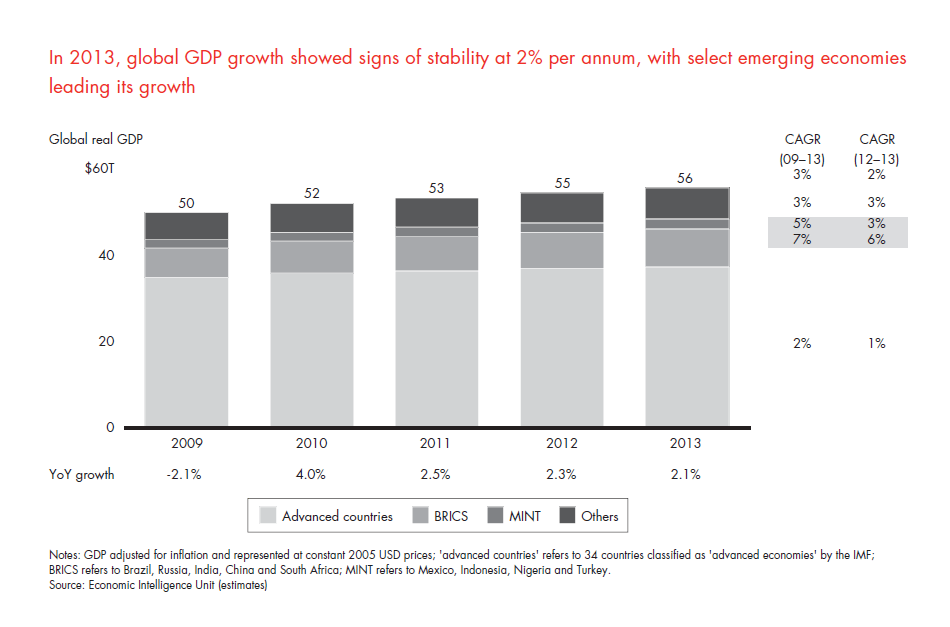
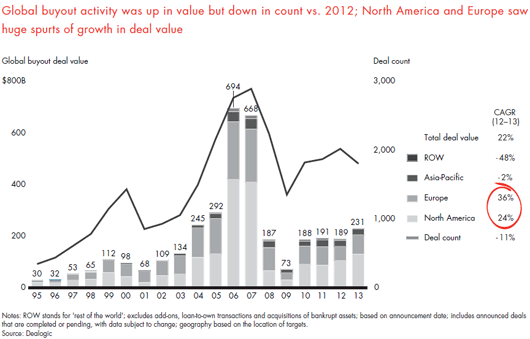
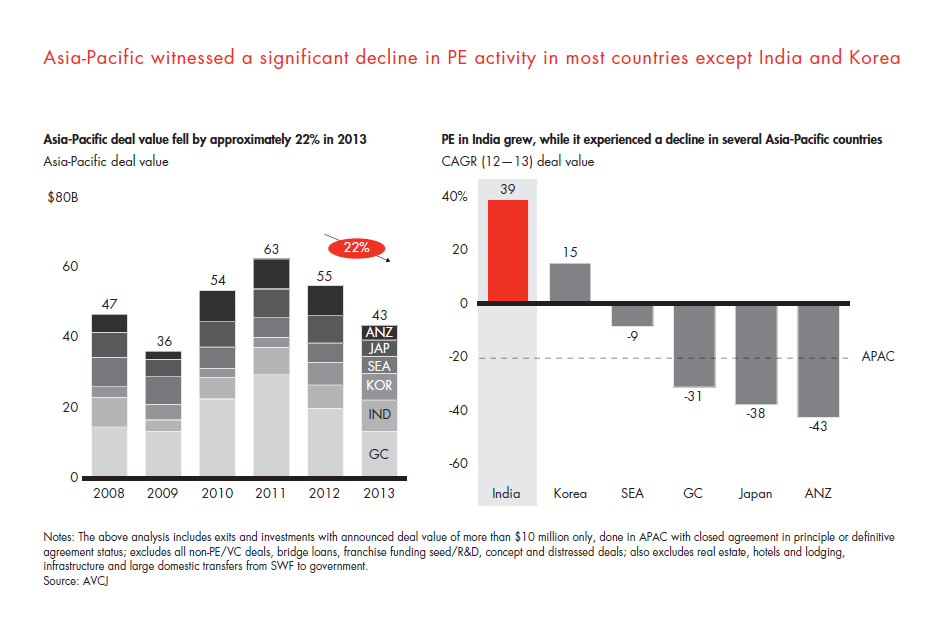
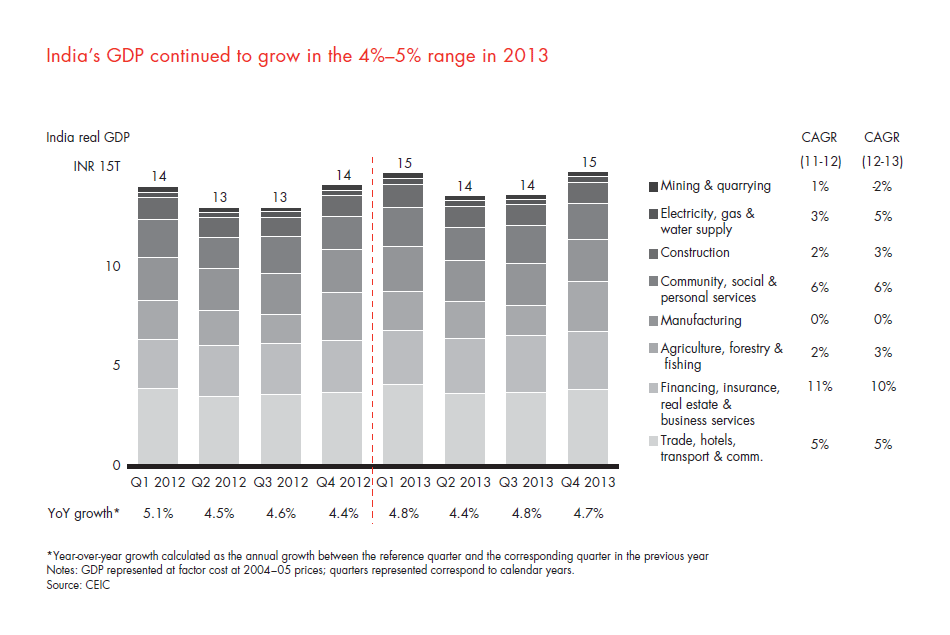
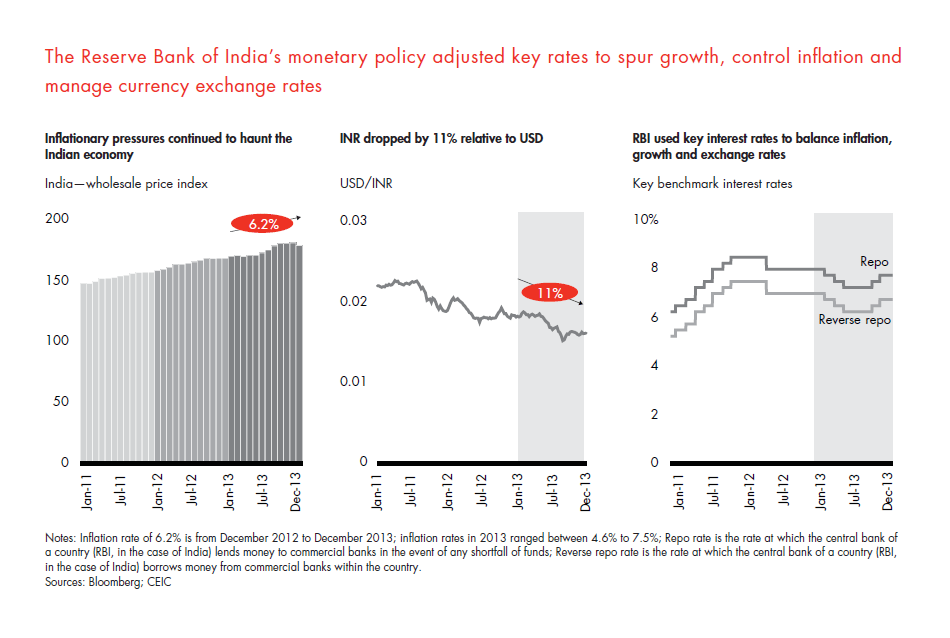
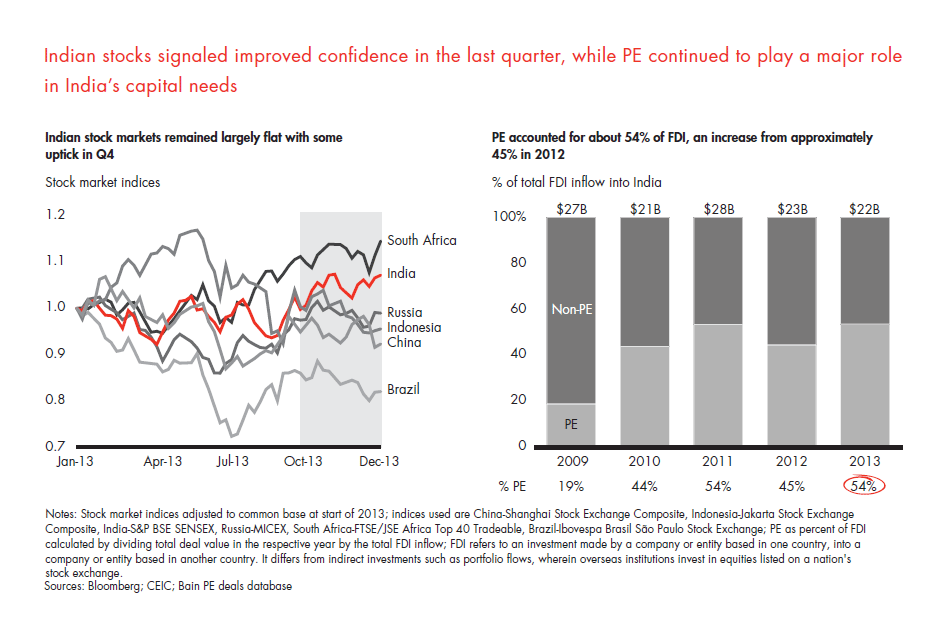
2. Overview of India’s PE landscape
- Indian PE and VC deal value increased by 16% to reach $11.8 billion in 2013 over 2012; deal volumes grew even faster at 26% over 2012.
- GPs pointed out that deal activity in 2013 was influenced by the macroeconomic situation, the exit environment and changes in valuation expectations. These factors are expected to continue to be key motivators of change in 2014.
- The number of PE and VC funds investing in India continued to increase. Approximately 150 funds from 2012 continued engaging in deals in 2013, while about 160 funds that did not invest in 2012 made investments in 2013.
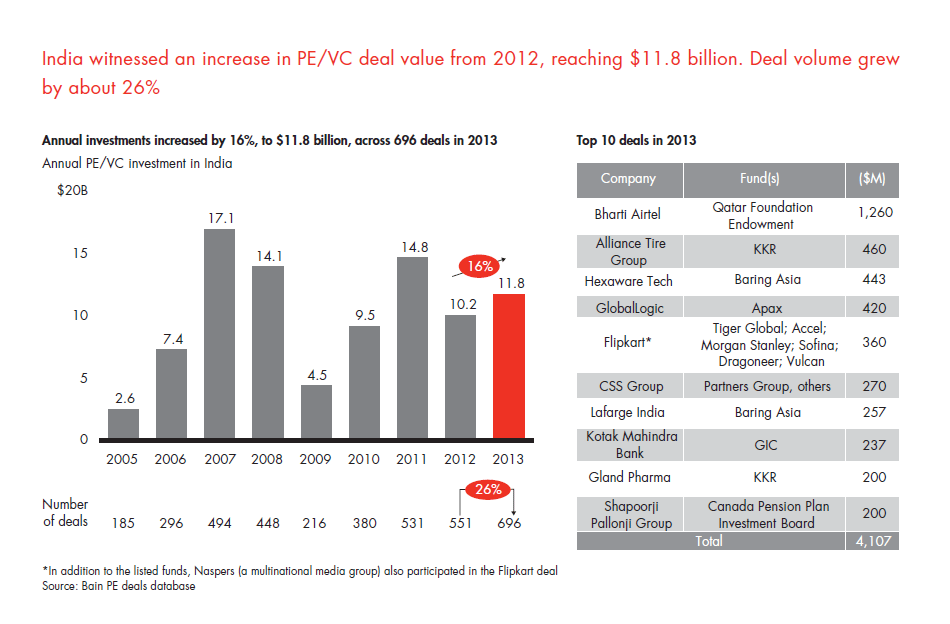
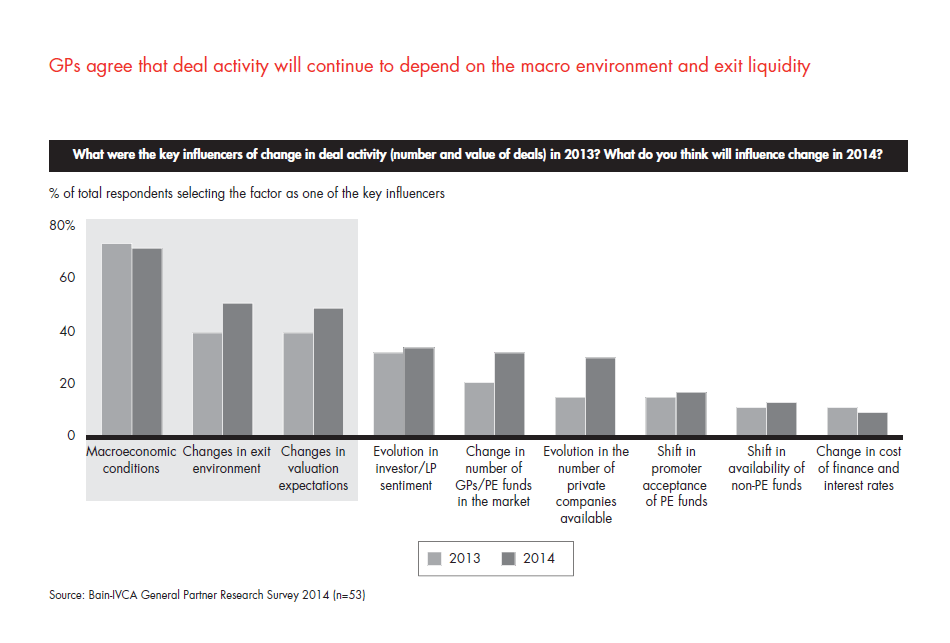
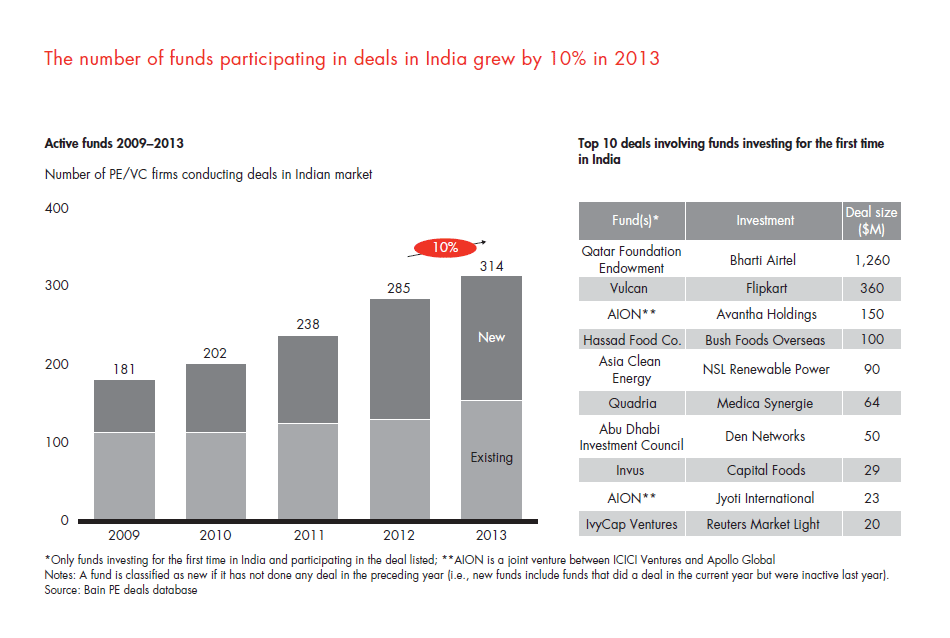
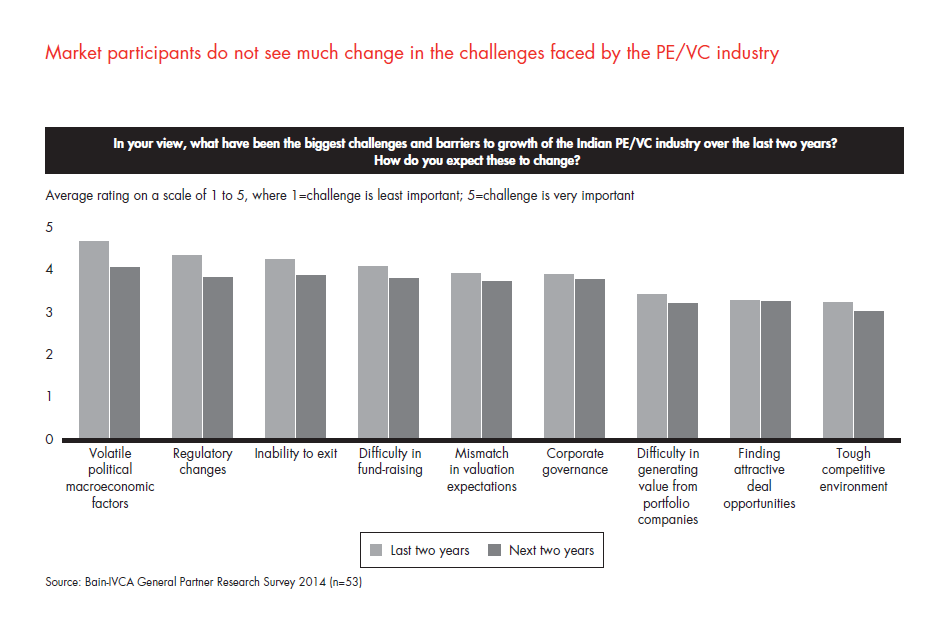
2a. Fundraising
- LPs have increased their scrutiny of GPs when allocating funds. GPs expect to see a larger number of co-investments with LPs in the future.
- 2013 saw continued growth in Asia-Pacific regional funds. Country-focussed fund allocation fell in China, India, Korea, Australia and New Zealand.
- Dry powder focussed on India dropped further, to $8 billion. However, there is sufficient capital in the market for deal making, as funds are available from regional allocations of Asia-Pacific and global funds.
- GPs surveyed believe that fund-raising will continue to be tough due to difficult macroeconomic challenges and poor experiences in the past. In the future, GPs will focus on building good investment and exit records to enable easier fund-raising.
- LPs consider PE funds’ team quality and industry focussed operational expertise as most critical when allocating funds. As a result, GPs are trying to differentiate most on industry expertise and credibility.
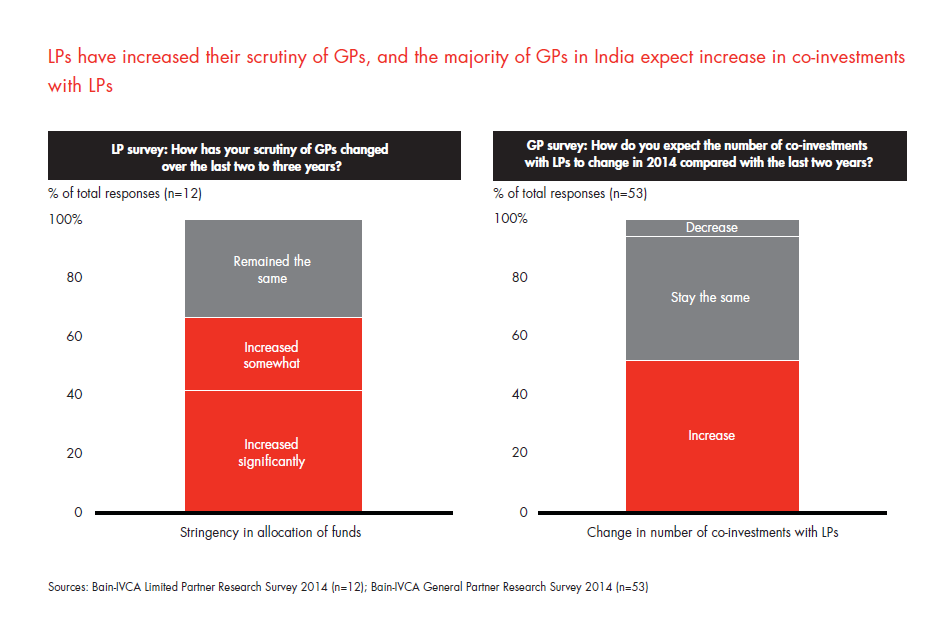
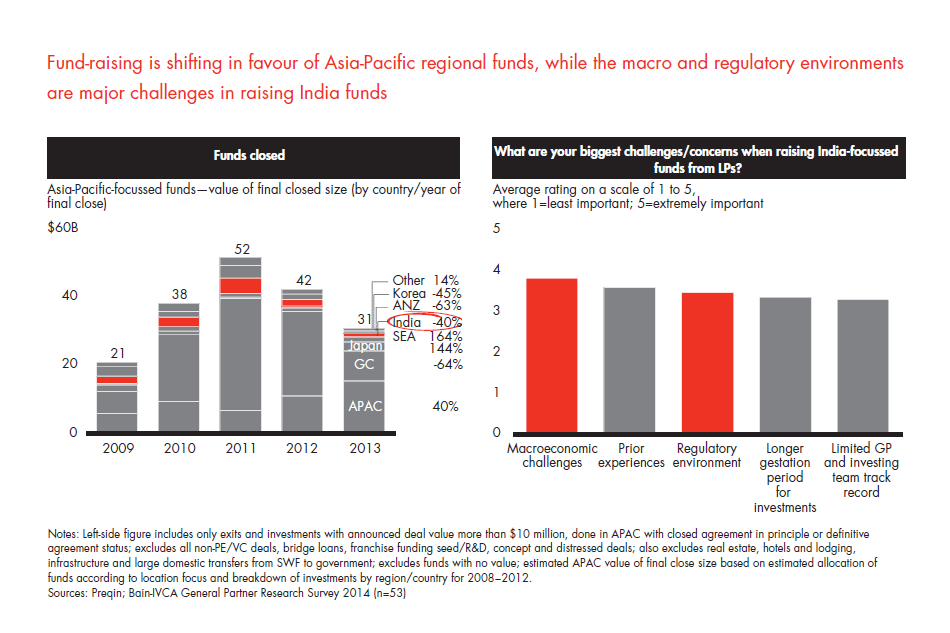
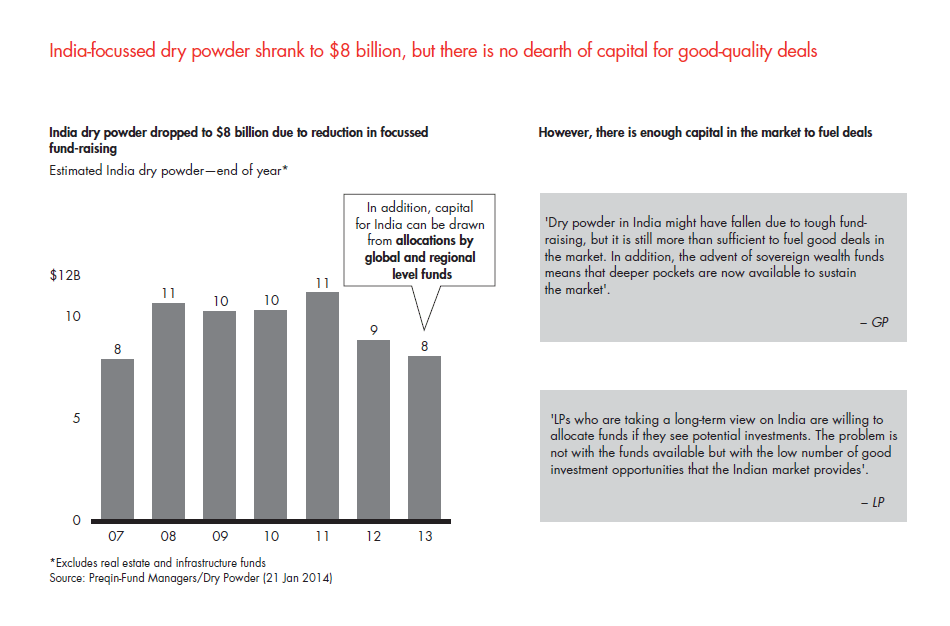
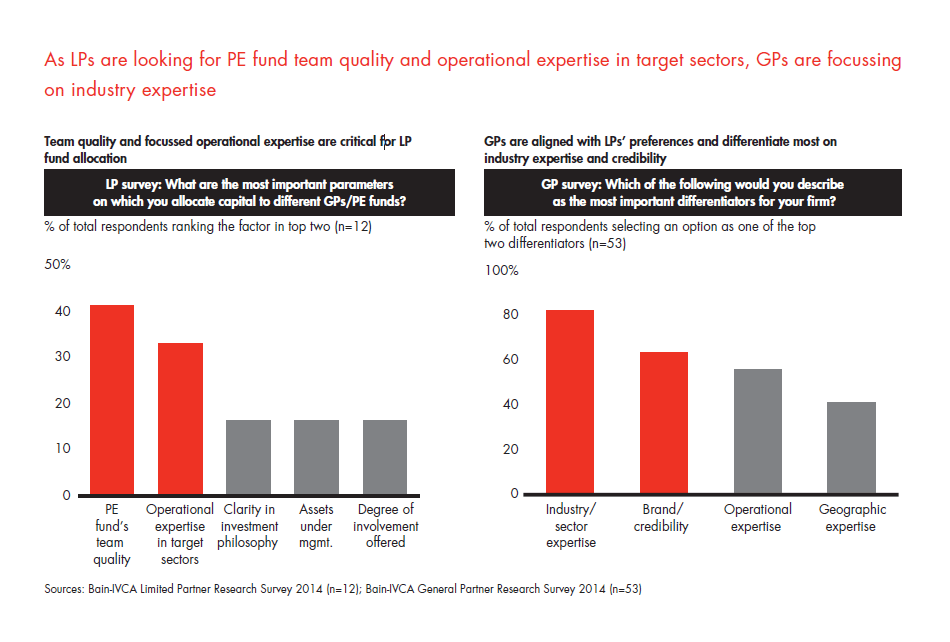
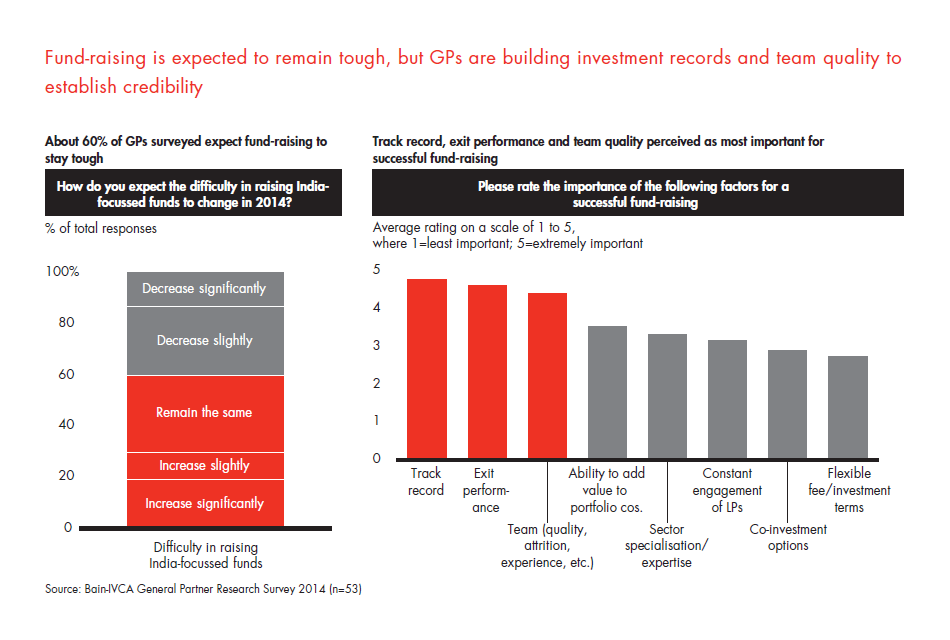
2b. Deal making
- Deal activity in India was robust in 2013 as funds invested grew at 16% and the number of deals jumped by 26%, driven by IT and ITES, healthcare and BFSI.
- The average PE deal size increased significantly from $35 million in 2012 to $41 million in 2013, fuelled by a growing number of large deals; GPs expect this trend to continue.
- The top 25 deals constituted 55% of total PE deal activity in 2013.
- Competition for deals is increasing, especially as sovereign wealth funds, LPs and strategic players get more interested in deals. However, valuations seem to be rationalising as PE funds become more selective in deal evaluation and stick to their investment philosophy.
- As a result of the disciplined approach, GPs feel positive about the potential to generate returns in India but agree that the investment horizon will continue to stay on the higher side.
- India continues to be a predominantly minority-stake market, with 50% of deal flow driven by early-stage deals; however, buyouts will continue to increase.
- Looking ahead, GPs are cautiously optimistic about growth in 2014 for the PE and VC industry, with the general elections being a wild card; most funds we surveyed expect an increase in investment targets after 2014.
- Healthcare, technology and IT and consumer products are expected to be the most attractive sectors for investment over the next two years due to underlying secular growth and dollar-denominated cash flow.
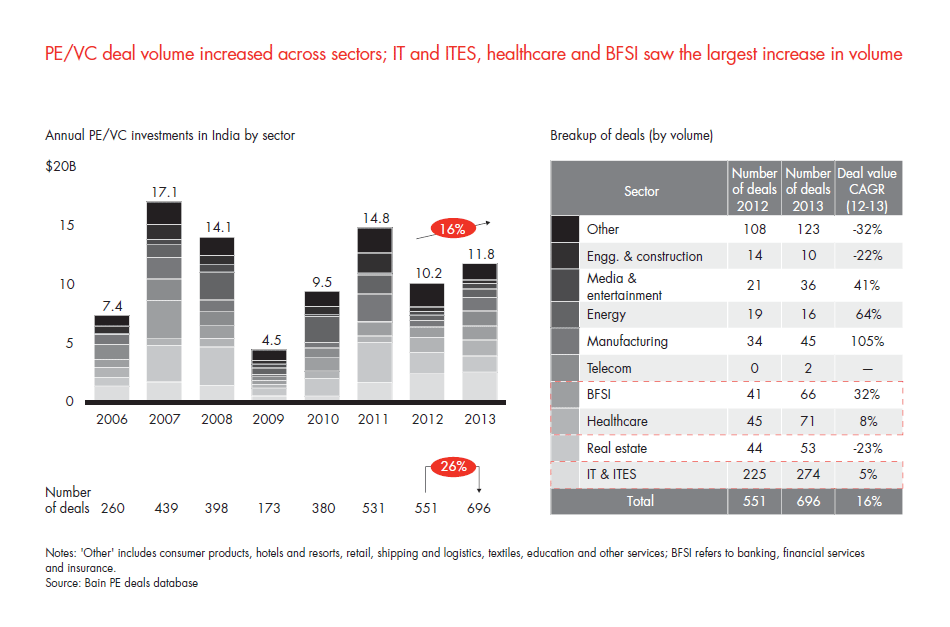
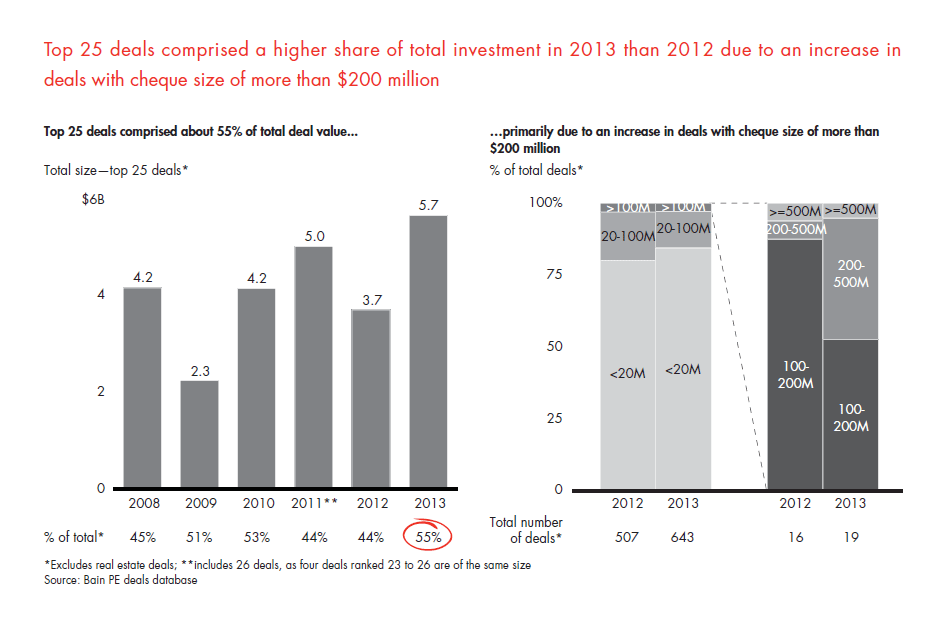
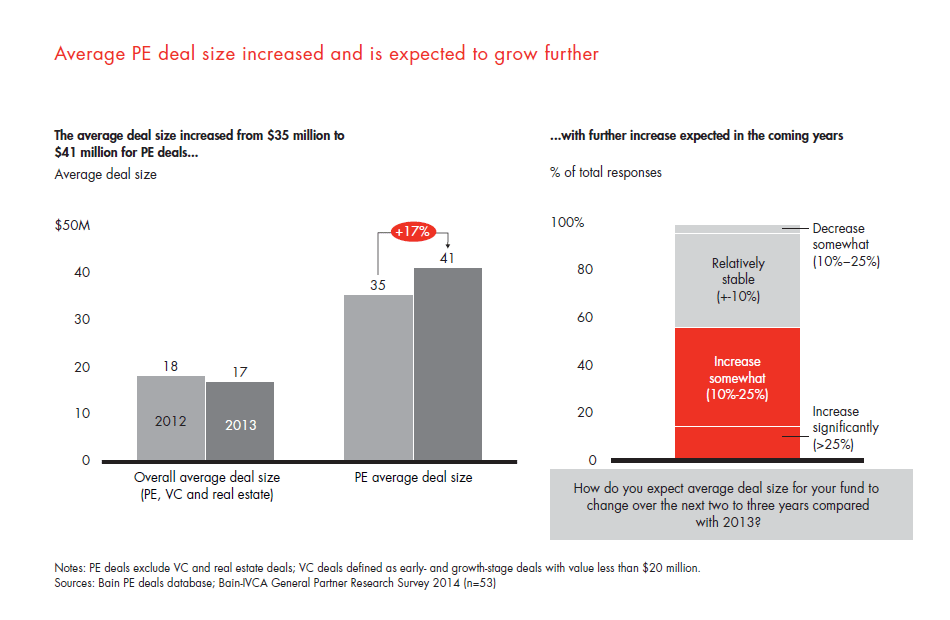
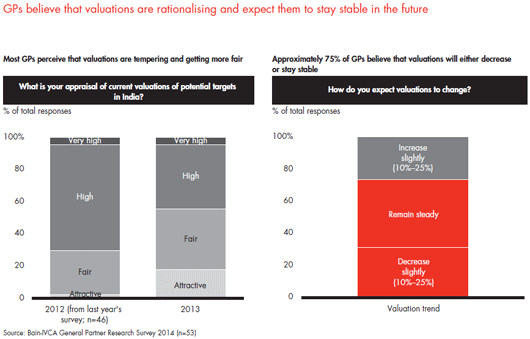
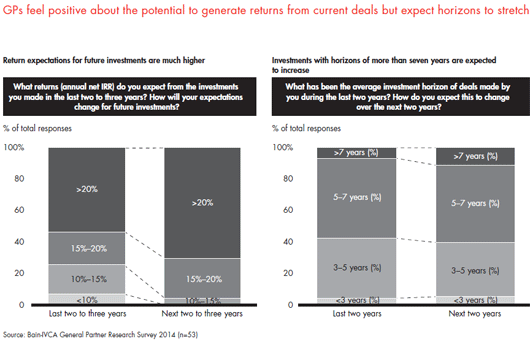
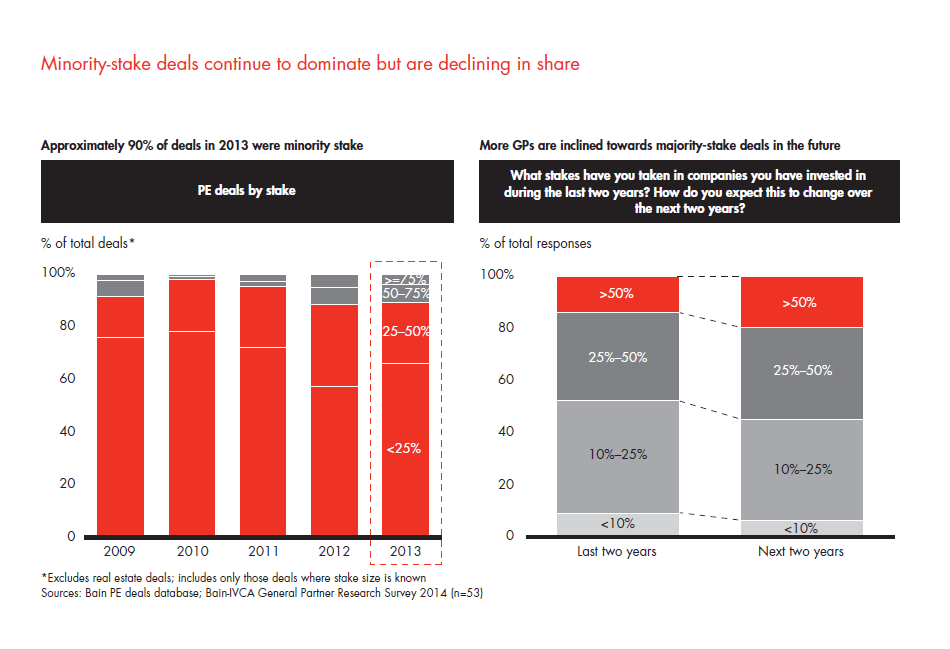
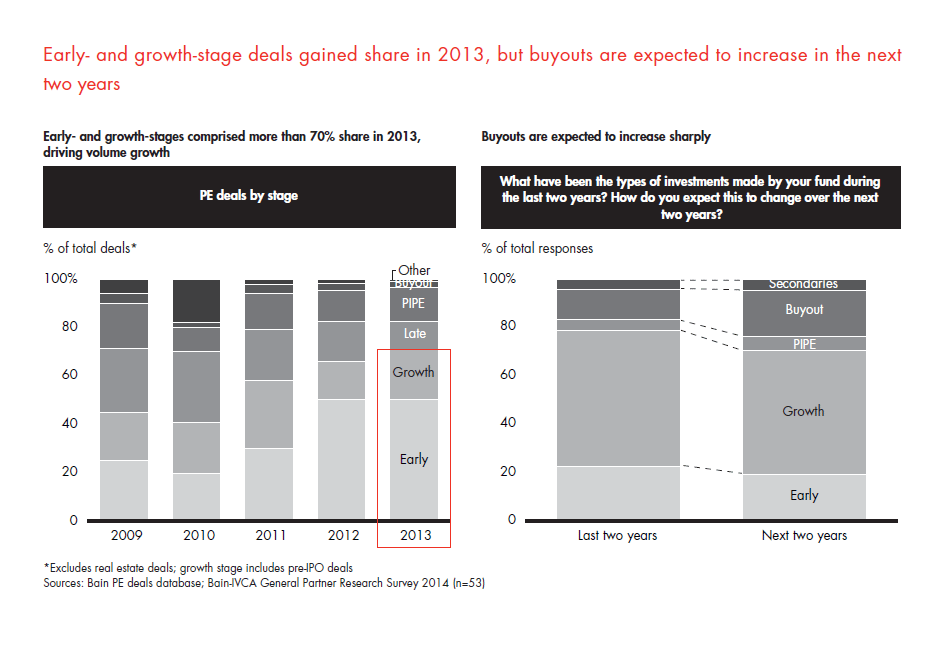
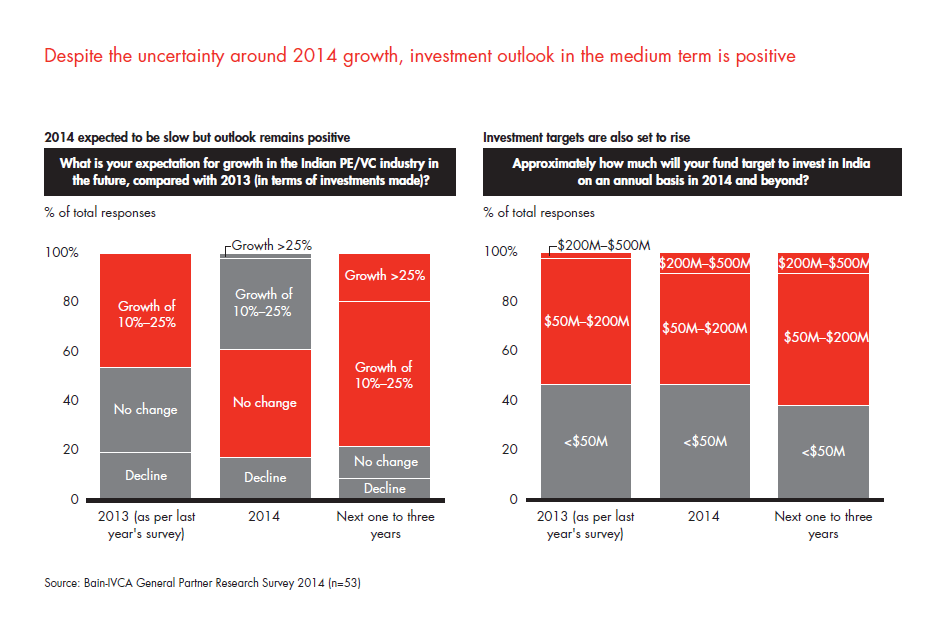
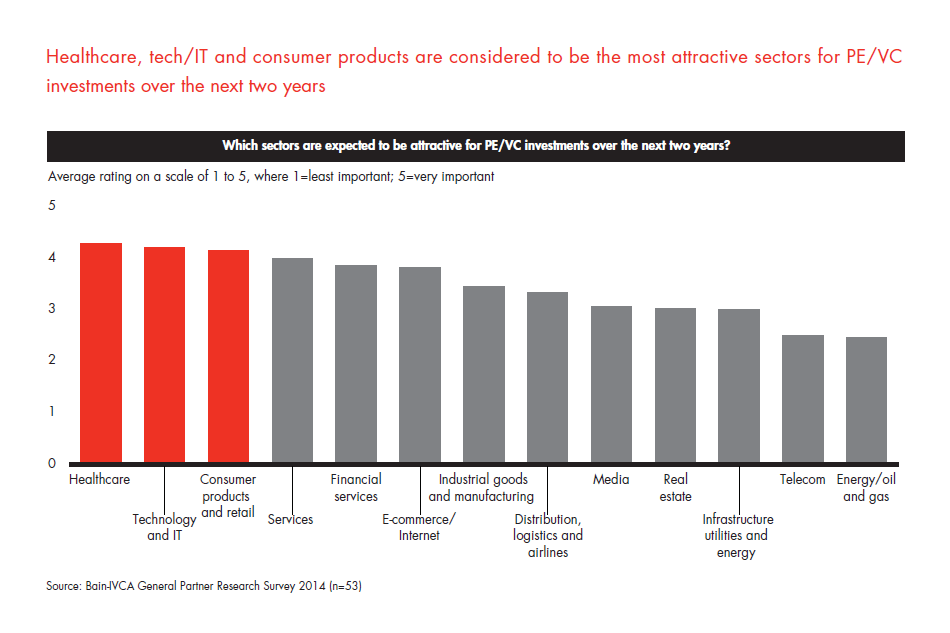
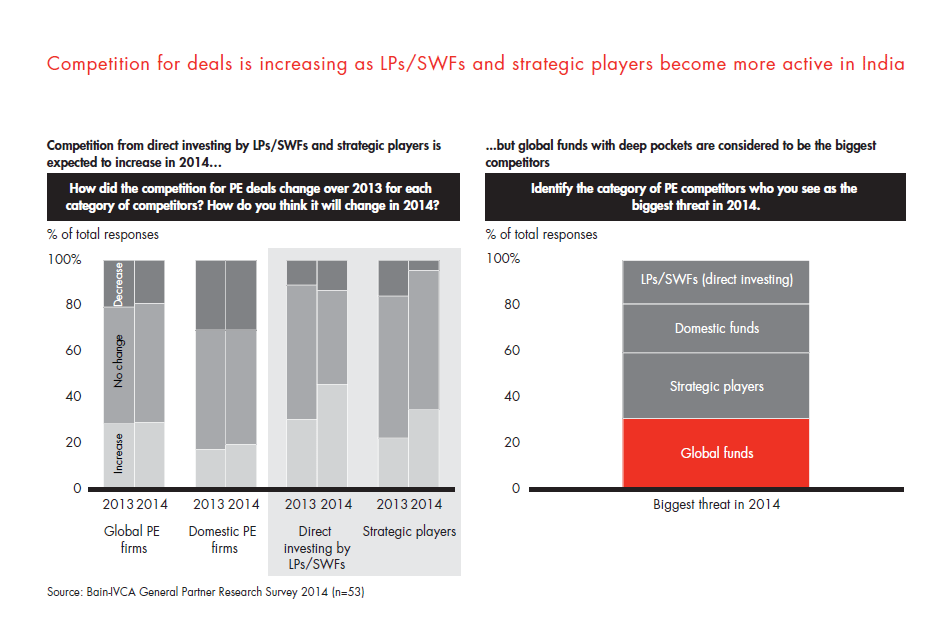
2c. Portfolio management and exits
- More and more entrepreneurs and management teams are recognising the value of PE and VC as patient and activist capital.
- GPs believe that valuations, referrals and sector expertise are the most important criteria for Indian entrepreneurs when seeking PE funding. The success in getting the deal closed is also influenced by the relationship built by the fund with the owner or management teams throughout the deal-making process.
- PE funds are strengthening their portfolio teams, and more than 50% of PE funds we surveyed intend to expand portfolio teams in the future.
- The total number of exits shot up significantly, by 43% in 2013, but the overall value of exits remained flat at 2012 levels of $6.8 billion.
- Only two sectors—IT and ITES, and BFSI—have shown good returns on the invested PE capital.
- Buybacks gained a significant share of total exit volume in 2013, as public markets continued to be tight and secondary deals are taking more time to close.
- Even as a large number of pre-2008 vintage deals stay in PE fund portfolios, most GPs seem to be readying their investments for exit and waiting for a resurgence in valuations (potentially after the elections).
- GPs anticipate a ‘rush to exit’ post-2014, with secondary and strategic routes gaining favour even as the IPO environment remains uncertain.
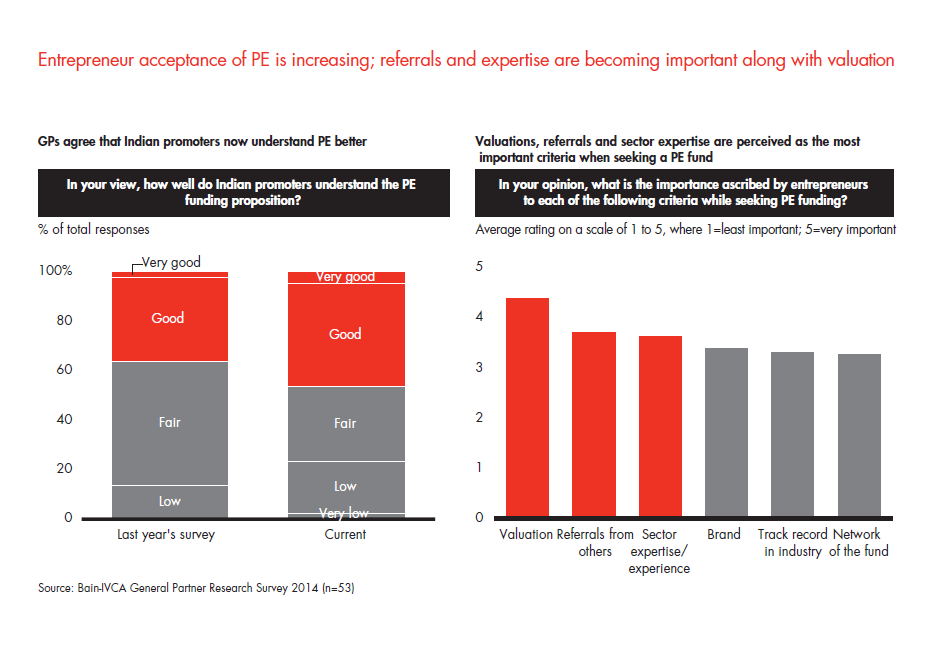
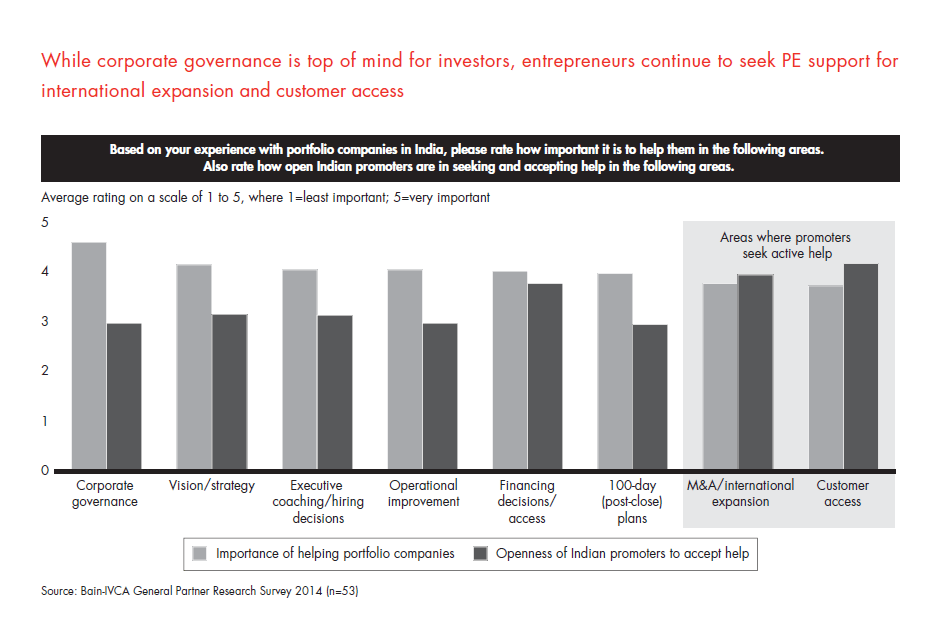
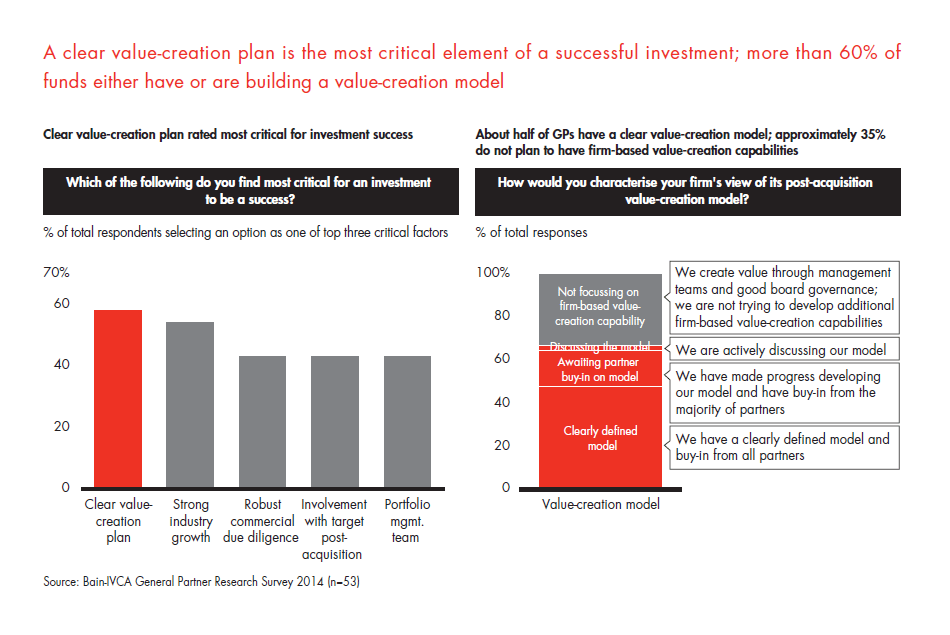
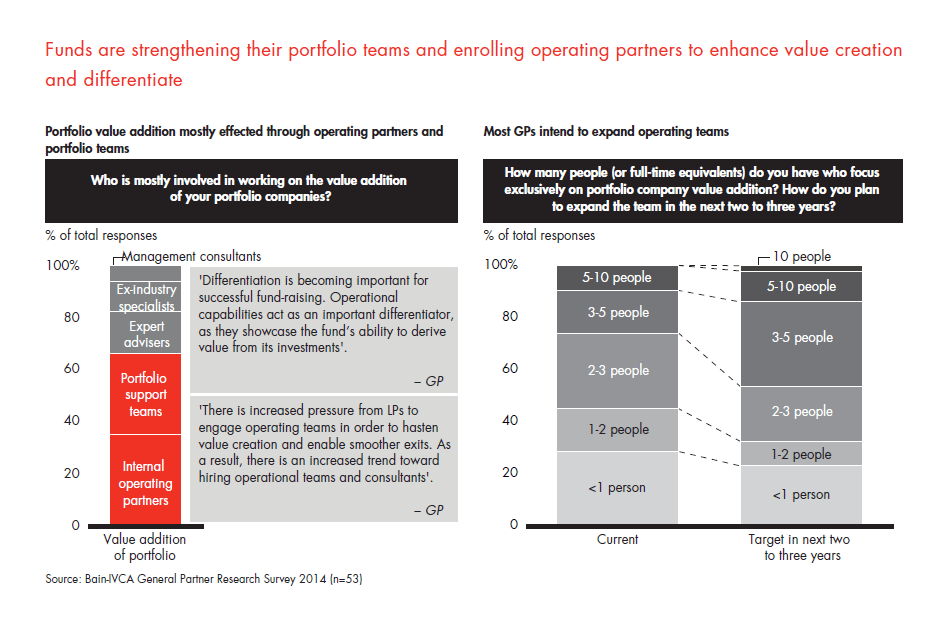
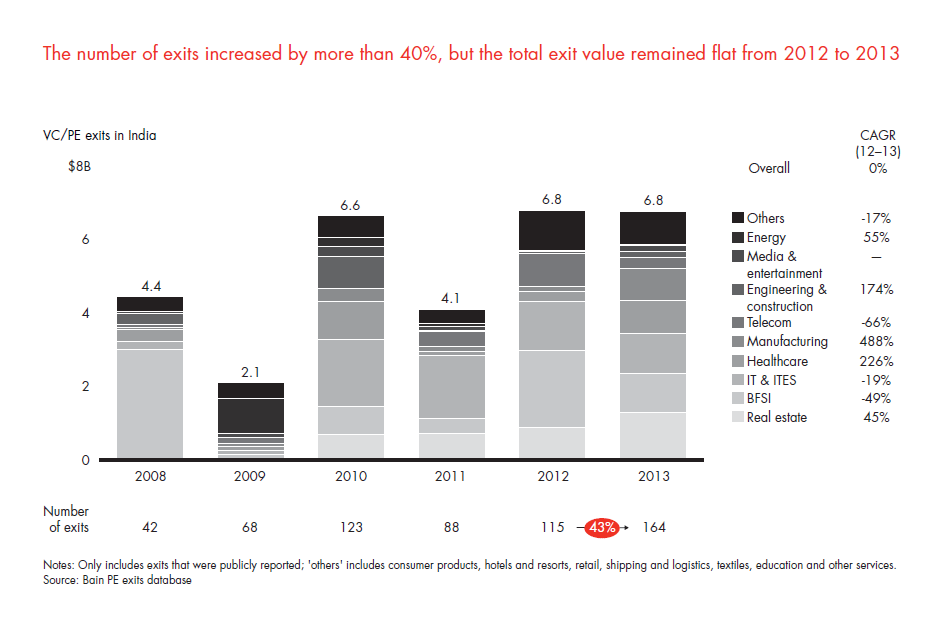
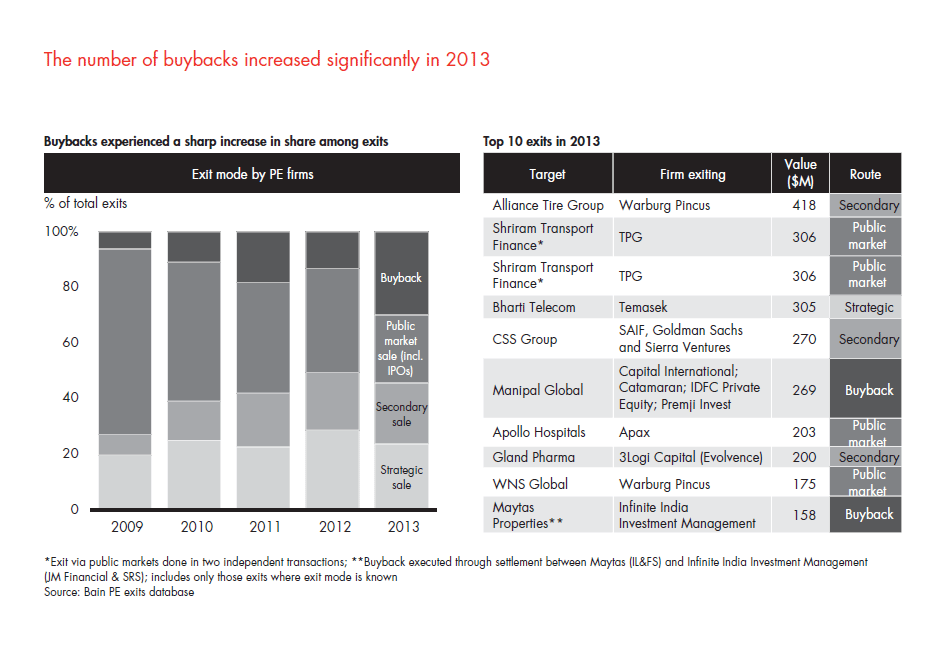
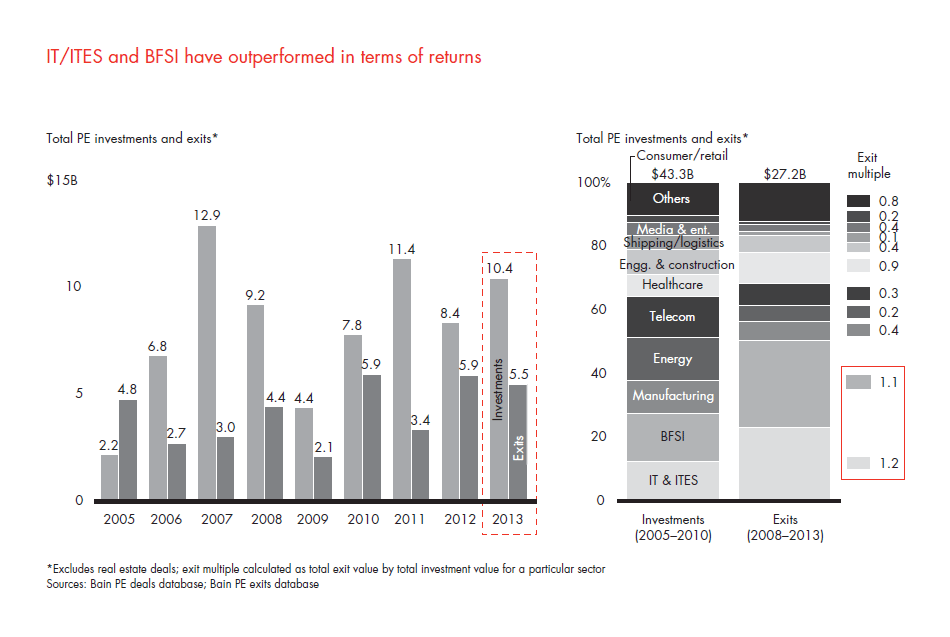
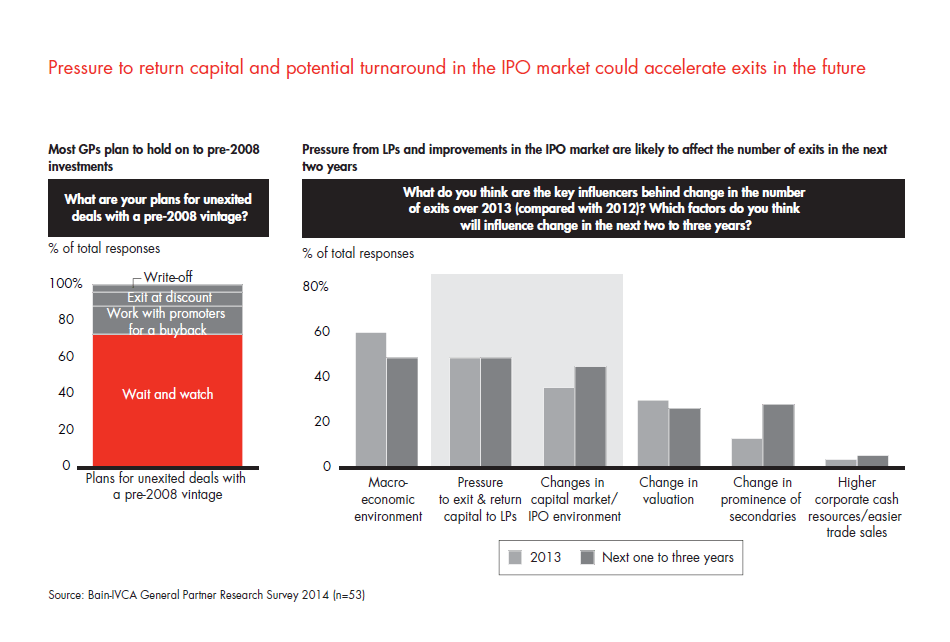
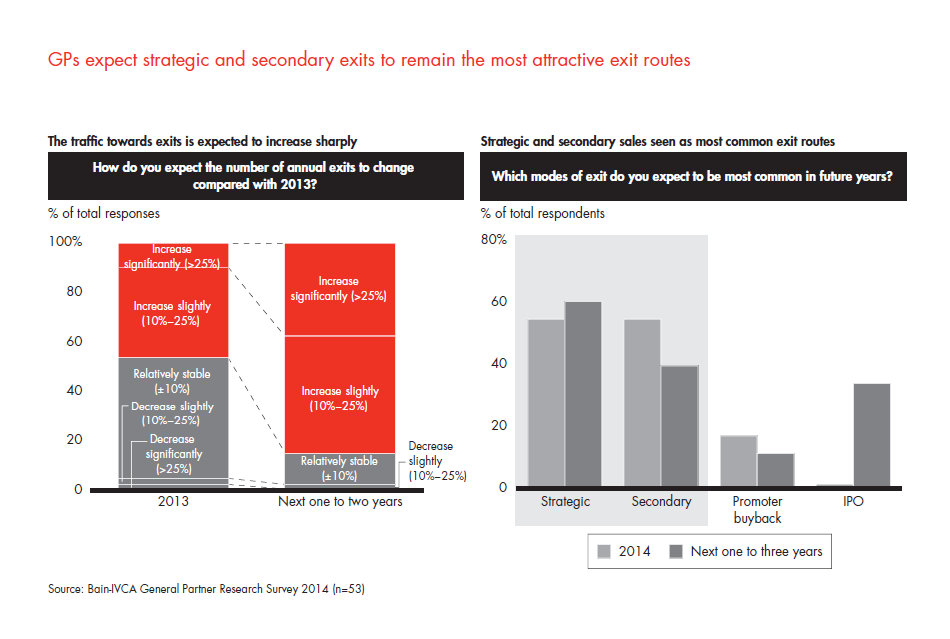
3. LPs' perspective of India: Rolling up the sleeves
- The importance of India for LPs has reduced as a result of slowing growth and increased competition from the next wave of emerging economies like sub-Saharan Africa and Southeast Asia.
- Allocation of funds to India will remain stagnant or decline in the near term due to negative investor sentiment.
- High entry valuations and macro and exit environments are major deterrents to investing in India. However, despite these challenges, LPs continue to believe in India’s long-term potential.
- The LP-GP relationship has become more interactive. LPs are more stringent when allocating funds and are showing increased involvement in deal making and fund disbursal by PE funds.
- LPs have lowered return expectations from India, and the impact of this is likely to manifest in LP–GP economics.
- In line with global trends, India has also witnessed a slow but steady movement towards direct investments by LPs in the private equity space.
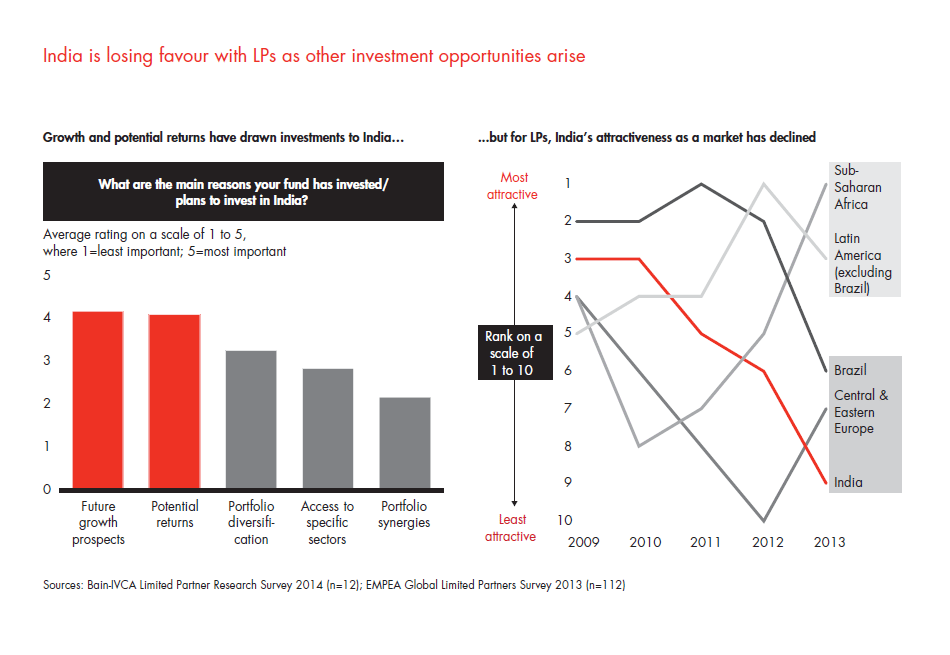
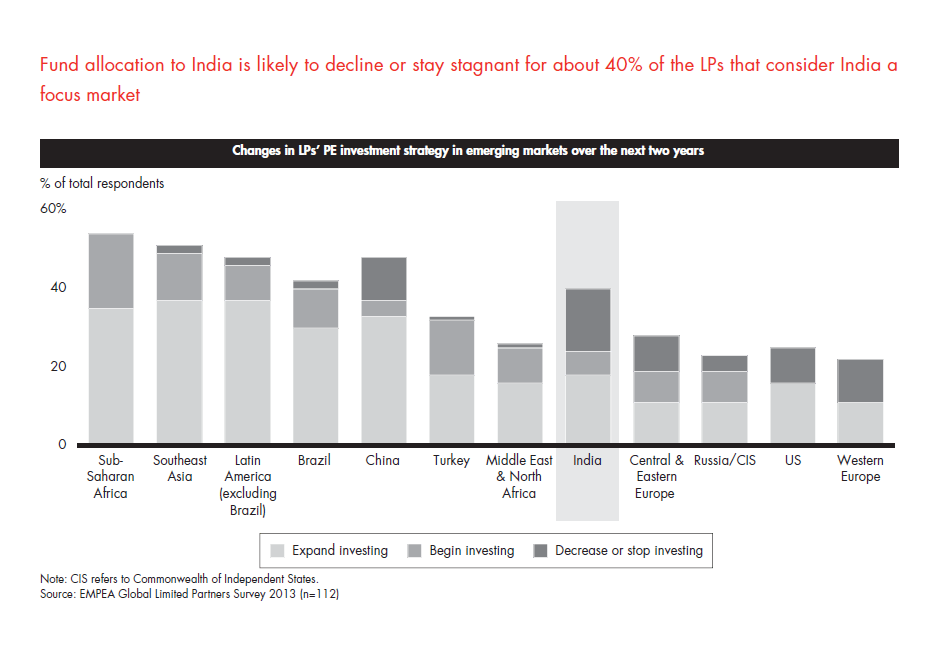
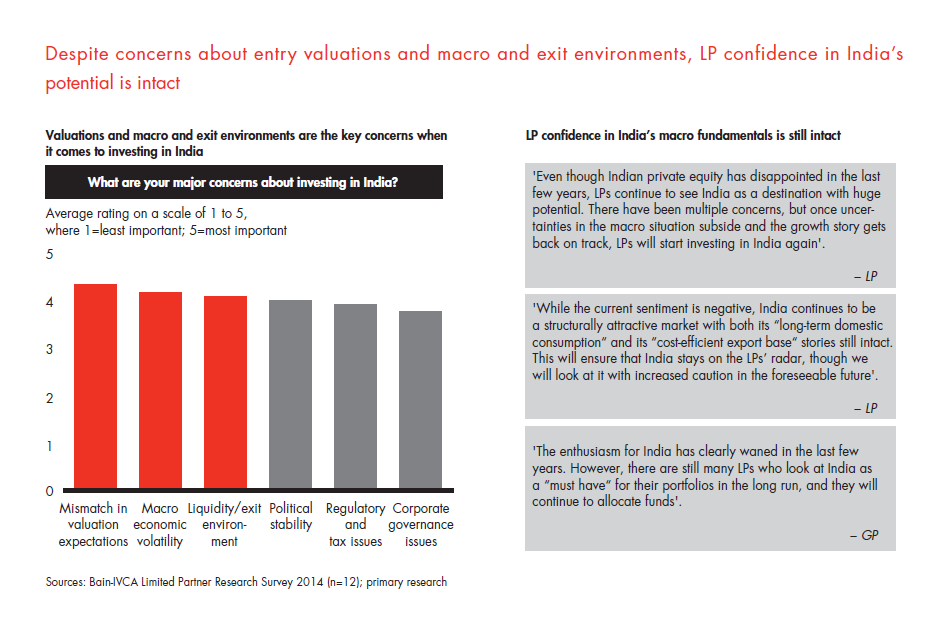
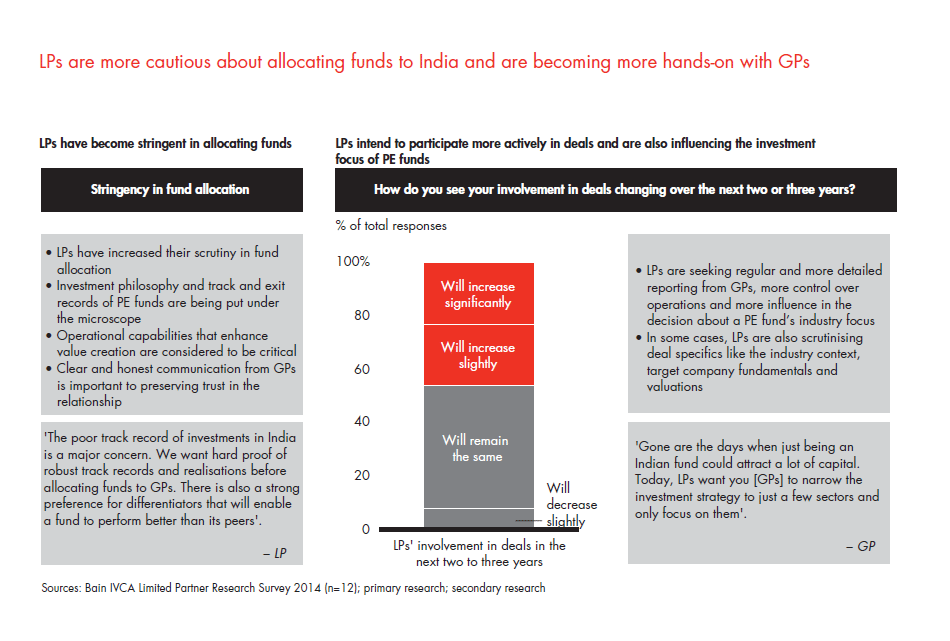
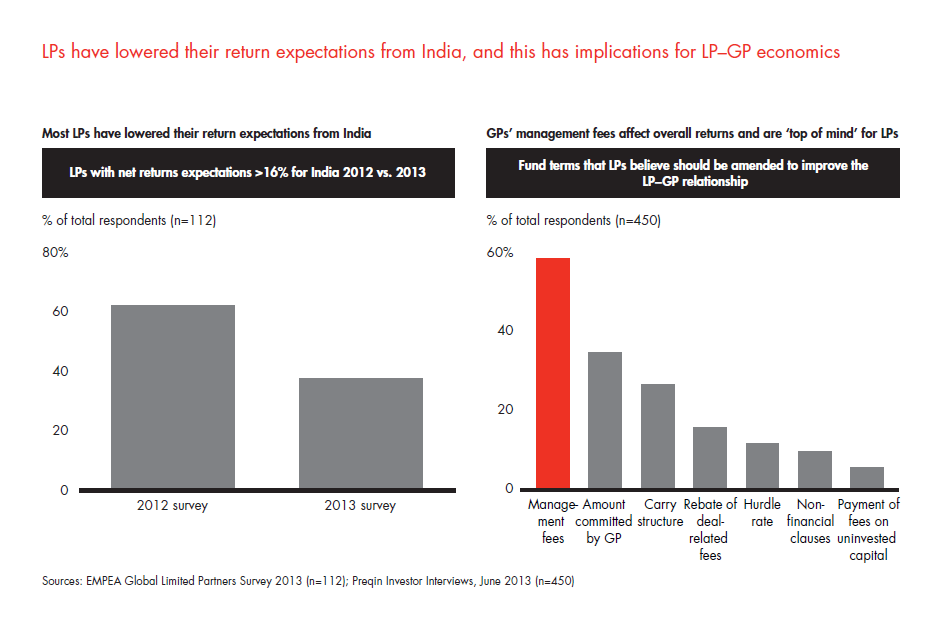
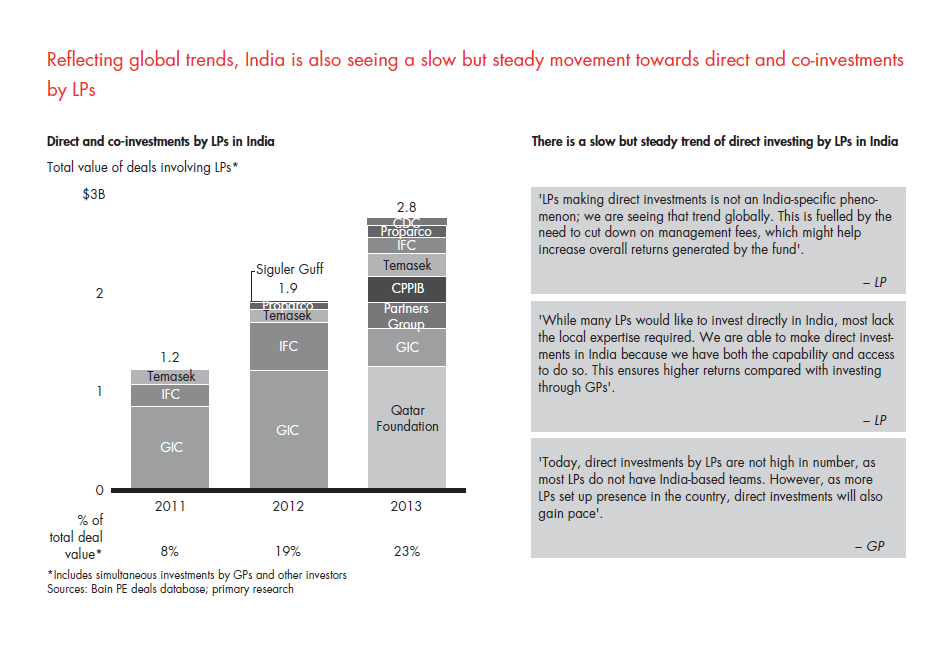
4. Implications
- GPs should continue establishing a strong rapport with promoters and management teams to land deals at the right valuations.
- GPs should carefully assess corporate governance issues and promoter integrity before making investments, and they should double down on creating a detailed value-creation blueprint within 90 days of the deal.
- Entrepreneurs should recognise PE as activist and patient capital and work with GPs to leverage the PE fund’s expertise and network in order to build a strong business with a long-term, competitive advantage.
- LPs should recognise the nuances of the Indian market and build an informed, firsthand view of returns and the investment horizon.
- It will be important for LPs to assess and understand the GP track record and ensure alignment of their investment philosophy with the LPs’ own risk appetite to achieve satisfactory results.
- Policy makers should appreciate the role that private equity can play in India’s growth story. Simplifying regulatory and tax frameworks to attract long-term capital can contribute significantly to boost both short- and long-term growth.
Implications
Overall, 2013 saw deal values rising, but it was a difficult year for private equity in India, as both fund-raising and exits proved to be challenging. The tough macroeconomic situation and the slower-than-expected pace of exits are forcing several market participants to get back to the drawing board and rework their strategy. PE funds are sharpening their focus on the best-quality deals based on their investment philosophy and are investing in relationships with promoters and management teams to conclude at reasonable valuations. In addition, the emphasis on value creation after the acquisition has gained more importance. The PE industry anticipates that favourable results in the general elections will spur a series of economic initiatives and lead to policies that will promote further investment in multiple sectors to boost both short- and long-term growth.
General partners: First, GPs need to double down on developing differentiated value-creation capabilities, which is not only critical to realise above-expectation returns but also to raise funds successfully. Second, GPs should continue investing in building a network with promoters and management teams well before the deal process; this is important, as it plays a key role in securing the deal at the right valuation and fosters a relationship based on trust. Third, there are attractive investment opportunities emerging in the secondary market. While some of these investments have not yielded financial returns as expected, these companies understand the PE value proposition and are more experienced in how to make partnerships with PE funds win-win. Finally, focussing on the ‘softer’ aspects of the deal is as important as landing the right valuation; these softer aspects include corporate governance and integrity of the leadership in the investee company.
Indian entrepreneurs: Those Indian entrepreneurs lacking prior experience with PE and VC should look at PE as activist capital, recognising the additional capabilities and network, that private equity can offer beyond just funding. Moreover, entrepreneurs should work with their private equity partners to think about business opportunities and challenges together. It is in the interests of management teams to help private equity partners appreciate market realities and seek their support where they might have expertise. This could be through leveraging their brand in the marketplace, improving their recruiting proposition when hiring a senior executive, requesting introductions with potential customers in the PE fund portfolio or learning and adopting best practices in corporate governance, working capital management and so on.
Limited partners: The Indian market is unique and governed by its own nuances. So it is imperative for LPs to fully understand the investment opportunity in India and assess risks in certain sectors or specific companies firsthand. This would enable LPs to set realistic expectations on the return potential and investment holding periods as they commit capital to India. The Indian market has matured over time, and the PE and VC industry is now at the close of a major investment cycle. As LPs seek to commit more capital and decide whom to trust with their capital, LPs should invest time to understand the track record of the fund and its GPs, and develop a clear understanding of alignment of the fund’s investment philosophy with their own risk-return appetite. Last but not least, LPs should encourage or discourage GP behaviours to ensure alignment with the investment philosophy throughout the investment term.
Public policy makers: Realising India’s growth aspirations requires a lot of capital. Private equity can play a pivotal role in bridging the gap between domestic sources of funds and the capital requirement for nation-building. Policy makers should re-evaluate the investment environment and regulatory framework around private investing in key sectors like education, healthcare and infrastructure, and explore opportunities to invite private capital to participate. The unique character of private equity as patient capital and its capacity to shoulder the risk in ventures differentiates it from conventional sources of funding. Creating a more conducive environment for private equity to attract funds and invest could make private equity an important contributor to the realisation of India’s growth story.
The year 2013 presented many challenges to the private equity industry in India—but the industry seems to be coming out of adolescence. While prospects for 2014 seem tough, there is the potential for recovery to accelerate if all industry participants work together. We believe private equity and venture capital investors should continue to be excited about opportunity in India. PE and VC are critical to foster entrepreneurship in the country and help Indian companies professionalise and scale up rapidly, thereby unlocking the true potential of India.
Arpan Sheth, the main author of this report, is a partner with Bain & Company in Mumbai and leads the firm’s Private Equity practice in India. Madhur Singhal is a principal in Bain’s Mumbai office, and Pankaj Taneja is a manager in Bain’s New Delhi office. They are both members of the firm’s Private Equity practice in India and co-authored this report.




































